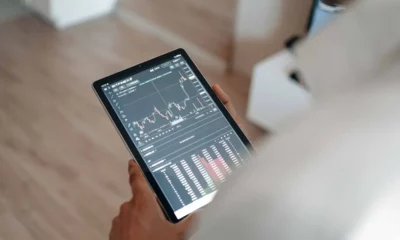Sponsored
4 disaster relief and detection technologies that save lives
Let’s explore some innovative disaster relief and detection technologies that are helping save lives in the wake of a natural disaster.

Just a heads up, if you buy something through our links, we may get a small share of the sale. It’s one of the ways we keep the lights on here. Click here for more.
Natural disasters like hurricanes and earthquakes don’t occur very often. But when they do, they cause widespread damage, putting people’s lives at risk.
These disasters can level the entire town, making it painstaking for search and rescue teams to find survivors.
About 387 natural hazards and disasters occurred worldwide in 2022. The Emergency Events Database EM-DAT reveals this. These events affected nearly 185 million individuals and resulted in the loss of 30,704 lives.
Advancements in technology, however, are helping people prepare for and respond faster to these events.
In this blog post, we’ll explore some innovative disaster relief and detection technologies that are helping save lives in the wake of a natural disaster.
NASA FINDER tool

The NASA FINDER tool has emerged as a pioneering tool for aiding disaster relief efforts.
FINDER—Finding Individuals for Disaster and Emergency Response—was developed at NASA’s Jet Propulsion Laboratory (JPL) in Pasadena, California.
Though no bigger than the size of a suitcase, FINDER locates disaster victims by detecting heartbeats under 30 feet of debris.
NASA’s FINDER tool sends a low-power microwave signal through the debris and observes variations in the reflections of the returning signals.
These are usually believed to be caused by tiny motions caused by victims’ breathing or the heart’s pulsation. FINDER identifies a survivor’s location by distinguishing these minute stirrings from the victim’s surroundings.
This technology has been used to find trapped survivors in disasters from Nepal to Mexico. In 2023, NASA sent its heartbeat-detecting tech to Turkey to help find earthquake survivors.
Starlink

Starlink, the internet venture of the billionaire entrepreneur Elon Musk, offers high-speed, low-cost internet to places where access is expensive, unreliable, or simply unavailable.
However, this constellation of thousands of satellites in low Earth orbit also serves as a valuable asset in disaster relief and detection efforts.
When a disaster strikes an area, traditional communication infrastructure is often compromised. In such times of crisis, Speedcast comments that establishing reliable communication networks is vital for effective disaster response.
A Starlink reseller can deploy kits within minutes and help affected communities maintain communication with relief organizations and emergency services.
This facilitates the coordination of rescue operations, helps disseminate critical information, and provides individuals in need with access to vital services.
Only recently, Fox Business disclosed that SpaceX’s Starlink satellites helped restore internet connectivity in Maui after devastating wildfires.
Another report reveals that the Tesla CEO’s Starlink systems were used by governmental agencies and in shelters in Japan after an earthquake struck the Noto Peninsula.
Apopo

Anti-Personnel Landmines Detection Product Development, or Apopo, is a non-governmental organization with Belgian roots.
Its goal is to help the world eliminate landmines and tuberculosis. Apopo tackles uniquely pressing humanitarian challenges.
It trains African giant pouched rats, nicknamed HeroRATs, to return safe land to communities and free people from serious illness.
Recently, Apopo collaborated with GEA to integrate these intelligent animals into Search and Rescue operations.
The rats, who possess an excellent sense of smell, are being trained to find earthquake survivors in a simulated disaster zone through sniffing.
Experts are training HeroRATs to pull a switch on their vest when they locate the target person in an empty room. This triggers a beep, and then they return to the base, where they are rewarded with a treat.
Apopo is currently working with the Eindhoven University of Technology to build a backpack that includes a location transmitter, a backpack, and a video camera.
This will allow for real-time communication with natural disaster survivors. HeroRATs’ agility and compact size, besides their exceptional sense of smell, make them ideal for the Search and Rescue Project.
Pano AI

Artificial Intelligence continues to make significant strides. One of the most compelling applications of AI is the one offered by Pano AI.
The California-based company has created an amazing fire detection system that combines satellite technology, AI, and ultra-high-definition cameras to detect fires at their earliest stages.
Pano AI’s innovative setup involves mounting high-definition cameras on mountaintops, from which they can scan the landscape.
AI then examines this footage to detect fires or smoke. It raises the alarm right away in case it detects a potential threat.
Noteworthily, this technology was able to identify and send out an early alert about the Kutch Road Fire in the Oregon region of Kutch Mountain.
The company’s system detected the fire and sent a full 14-minute warning before the first 911 call was made.
Some current customers of Pano AI include the Big Sky Fire Department, Holy Cross Energy, Portland General Electric (PGE), Xcel Energy, and PacifiCorp.
Putting it all together, the capacity of human beings to respond to disasters has significantly improved– all thanks to the developments in disaster relief and detection technologies.
The technologies discussed aren’t the only ones revolutionizing our approach to disaster management.
Apple’s ‘Emergency SOS,’ JAXA Japan, and UAV Navigation are some other techs that are helping save the lives of people, minimizing the devastating impact on communities and ecosystems.
Have any thoughts on this? Drop us a line below in the comments, or carry the discussion to our Twitter or Facebook.
Editors’ Recommendations:
Disclosure: This is a sponsored post. However, our opinions, reviews, and other editorial content are not influenced by the sponsorship and remain objective.



































